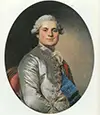The French King Louis XVIII
Louis XVIII was King of France in the early 19th Century, following the ouster of Napoleon Bonaparte. Louis's reign began the Bourbon Restoration. He was born on Nov. 17, 1755, at the Palace of Versailles. The reigning monarch at the time was his grandfather, King Louis XV. His father, also named Louis, had four sons in all. The three oldest were named Louis; the youngest was named Charles. 
The youngest Louis excelled in his studies, particularly in the classics. As a younger son, he had a religious education as well. He had a love for reading and eventually acquired more than 11,000 books. Louis Stanislas, as he was known, married Prince Maris Giuseppina of Savoy on May 14, 1771. Husband and wife did not get along, and they had no children. The two oldest boys named Louis had died by 1774, when Louis XV died, as had their father, so the king's third grandson, also named Louis, became Louis XVI. His younger brother was very fond of spending money, and the new king had to pay off a large amount of his brother's debt. The fourth son Louis, also known as the Comte de Provence, remained in Paris when the French Revolution began but left in June 1791, settling in the Austrian Netherlands. At the same time, his brother the king and his family were caught trying to flee the country and were sequestered in Paris. The monarchies in Europe declared themselves in opposition to the Revolution and schemed to return Louis XVI to the throne. The Comte de Provence played a part in such schemes, including enlisting the support of royals and other nobles who fled France. When the king and queen were executed in 1793, the Comte de Provence declared himself regent for the heir apparent, the king's son Louis. Many people referred to the dauphin as Louis XVII even though he was never crowned; and when he died in June 1795, the Comte de Provence declared himself Louis XVIII. He was still uncrowned and spent the next 19 years in a handful of other European countries, among them Germany, Italy, Prussia, Russia, and the United Kingdom. He refused to give up on his dream of being King of France and found his patience rewarded in March 1814, when Emperor Napoleon Bonaparte abdicated the imperial throne and the people of France agreed to a restoration of the monarchy, with Louis XVIII on the throne. This became known as the Bourbon Restoration. Louis promised to be a constitutional monarch and to abide by the Charte Constitutionnelle, which came into being on June 4, 1814. The new government had a two-house parliament, made up of the Chamber of Deputies (lower house) and the Chamber of Peers, and was built on policies of religious toleration and equality for all. When Napoleon returned to power in the Hundred Days, Louis XVIII fled to Ghent. He returned on July 8, once Napoleon had been well and truly defeated at the Battle of Waterloo and exiled a second time. 
Back in power, Louis turned over a large part of his monarchical duties to the Ministére de Roi (Royal Council) and to the country's first Prime Minister, Charles-Maurice de Talleyrand. The king also discouraged reprisals against any supporters of Napoleon who remained. Nonetheless, he wasn't exactly in charge of everything in the way that the absolute monarch Louis XIV had been. During a period known as the White Terror, a powerful segment of the population carried out a series of purges of anti-Bourbon officials, numbering in the tens of thousands, and punished the remaining leaders of the army that Napoleon had led into battle. Among the casualties was the famous Marshal Michel Ney, who was executed for treason. The king had approved of the punishment of the military leaders but not the wanton punishment of civilians. The Chamber of Deputies had in its membership a large majority known as ultra-royalists, who were considered more conservative than the king in their desire to restore the prominence of the monarchy and the Catholic Church. Louis XVIII called this chamber the Chambre introuvable ("Unobtainable Chamber") because he could not convince it to agree with his more moderate policies. Even Talleyrand, who had saved France from dismemberment at the Congress of Vienna, held no sway against such a force. He resigned, and the king replaced him with the Duke of Richelieu. In 1818, Richelieu signed off on a very large expenditure of money to the Allied powers who had kept occupation troops in France after Napoleon's defeat at Waterloo. The ultra-royalists, by this time joined by the king's younger brother, Charles, the Count of Artois, continued to hold sway. The king's wife had died in 1810. They had had no children. The heir apparent was the Count of Artois. The king, who had long struggled with obesity, suffered in his last years from gout and gangrene. His favorite nephew, Charles Ferdinand, duc de Berry, was the victim of assassination in 1820, and the king lost his desire to fight against the ultra-royalists. Led by the Comte de Villéle, they took over the ministry and the government and passed laws that benefited the rich and took away civil liberties. One of the king's last official acts was to celebrate the triumph of French troops, led by the king's nephew the Duke of Angoulême, in helping the Spanish King Ferdinand VII put down a revolt in 1823. The French armed force came to be known as the Hundred Thousand Sons of Saint Louis. King Louis XVIII died on Sept. 16, 1824, at the Louvre Palace. His brother became Charles X. |
|
Social Studies for Kids
copyright 2002–2024
David White




